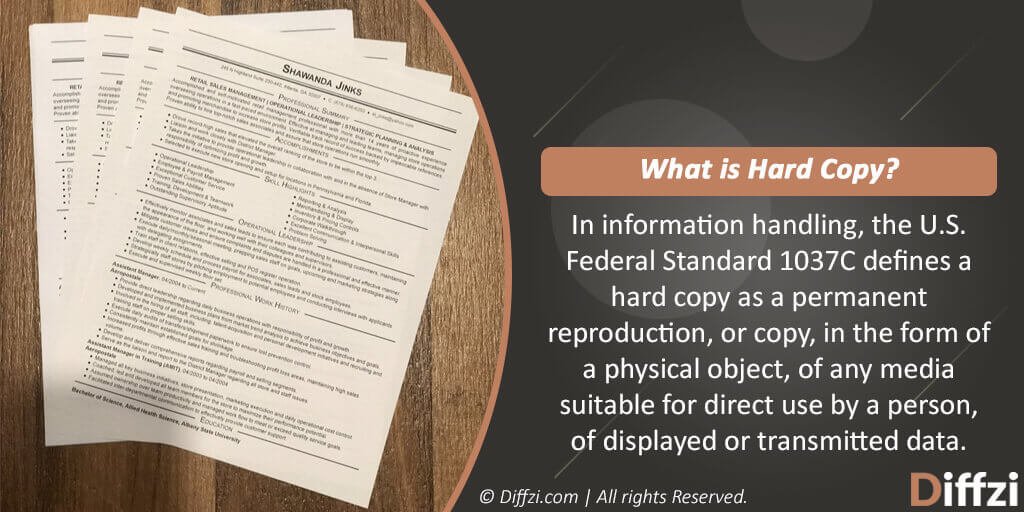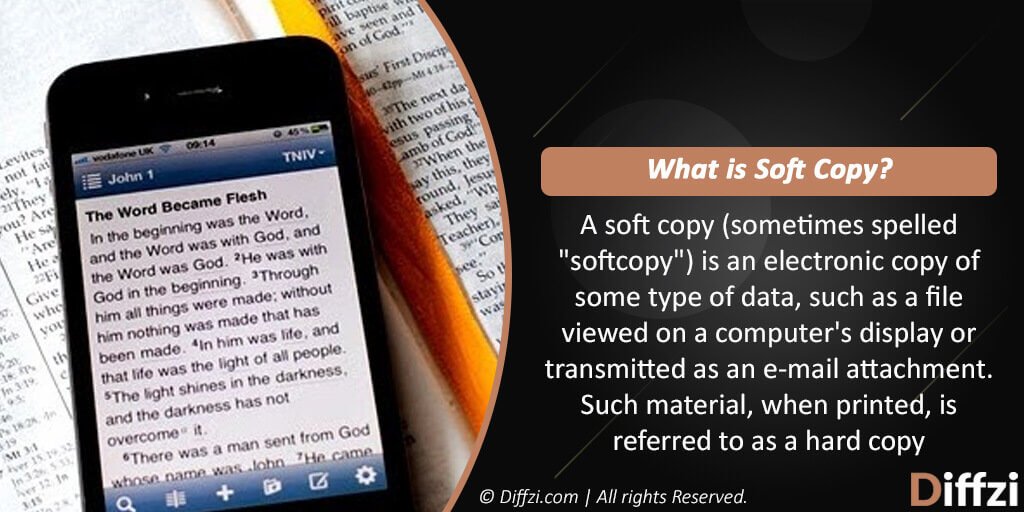Today any type of readable and writable data can be shaped into two different forms. Either in the form of soft copy or in the form of hard copy. The basic purpose of these two is the presentation or storage of written material and data. The purpose of this article is to draw a fine line between hard copy and soft copy and clear the minds of readers about any confusion of both terms.
The term hard copy means something touchable, physical and tangible while soft copy means data or information which can be stored in any kind of digital memory.
Comparison Chart
| Basis | Hard Copy | Soft Copy |
| Cost | More expensive | Less expensive |
| Portability | Portability issues | No portability issues |
| Preserved | Less chance of being preserved for a very long time | Can be preserved for a very long time |
| Transmission | Mail, hand to hand. | Electronic mail, digital, internet. |
| Nature | Physical in nature | Logical in nature |
| Editing | Editing/Manipulating is harder | Editing/Manipulating is easier |
What is a Hard Copy?
The term hard copy itself describes something touchable, physical and tangible. And copy means the result of production or information. So the collective meaning of hard copy is, production of any record or information in a physical object or form. Printed books, newspapers, magazines, documents, etc. all are kinds of hard copy. A hard copy is an older way of keeping the record in physical form. Although technology has been changed but still old is gold. Property papers, contracts, agreements and other signed documents are still required to be kept in physical form or hard copy to prove your point.
Teleprinter pages, books, computer printouts and likewise pages and printouts are the best examples of hard copy. It is considered as an old way of representing the data but still the widely used medium of data and information in the modern world. The term hard copy sometimes also used for computing purposes as well. But make it clear that non-printed punched paper tapes, diskettes, CDs or any kind of magnetic tapes are not considered as the hard copies.
The hard copy is highly associated with the printing of newspapers, books and likewise printouts. Despite the fact that there are many advantages of using hard copy but this system is gradually decreasing because it involves huge cost and wastage of time. You can’t easily share the hard copy in case of the original one with anyone living in another country. In case of giving another hard copy of the document to anyone means there will be printing cost. But still, the hard copy is generally accepted as the authentic medium of information. In case of the validity of the document, signatures are taken on the hard format documents.

What is a Soft Copy?
Soft copy means data or information which can be stored in any kind of digital memory. It is an intangible form of preserving the material. You can see the record but cannot touch it. Monitors or other display screens are used to see the soft copy results. Soft copy is the latest form of preserving the material and information in a digital form. With the invention of the computer, the concept of soft copy came into existence.
Among a lot of advantages of having soft copy two main advantages of the soft copy are that you can anytime send the data via email and can preserve the data without having an actual physical place. In short, you can get rid of courier services and bulky files. Unlike hard copy, it is not stored or printed over physical paper rather available in the form of digital document files like digital text format, image format or any other presentation format. PDF, doc files, xlx files, presentation files, etc. are the best examples of soft copy.
Instead of viewing via any physical media, these are accessed through database programs, word processing programs or through any presentation program subject to the format of the files or data. These can be transferred from one PC and operating system to another PC or operating system through USB drives, external disk drives or online sharing and downloading.
There are many advantages of using soft copy as it makes the environment of office paperless. But at the same, the credibility of soft documents are still at stake. Despite the fact that the digital signature system has been introduced but still the signature fixed on the soft copy is not regarded as the genuine one and not authenticate the credibility of the document.

Key Differences between Hard Copy and Soft Copy
- Producing soft copy is less expensive than producing a hard copy. Compiling a single book in hard format will be more expensive than producing an eBook on any word processing software.
- Soft copy has no weight. Weight is just of the media on which it is stored. Hard copy carries some weight. Having the bulk of pages of hard copy means large amount of weight as well.
- Soft copy requires no physical space as compares to hard copy. Sometimes hard copies required a special record room or portion of the cabinet.
- Hard copy cannot be preserved for a long time. Chances of termite become even higher in the case of old files and documents.
- Hard copy is beneficial in the sense that it is touchable and can be read out easily. While soft copy sometime requires special software to read and access.
- Soft copy is beneficial for the environment as it cuts the cost of papers, ink and printing. Hard copy requires all this material to get the shape.
- Although the soft copy is becoming more popular than hard copy still hard copy is used as a medium of evidence in case of legal disputes.
- Manipulating with the material of soft copy is easy than that of hard copy.
- Soft copy is a digital and electronic form of material while hard copy is a physical and tangible form of material.
- Electricity or any kind of power is necessary for soft copy, which is not required in case of hard copy.
- Hard copy is a printed document while the soft copy is an unprinted digital document.
- A soft copy can be shared with others by way of transferring via USB or external disk drives or attaching via email or by way of cloud sharing. Hard copy can be shared with others by way of getting another photocopy.
- You can make as many copies of soft copy as you can. This requires simple copy and paste and requires to additional cost. A copy of hard copy means another print out of the same document that requires additional cost.
- Hard copy requires extra gadgets for reading purposes except for the paper on which it is printed while soft copy can’t be read out without any word processing, database or presentation program subject to the format of files or data.
- Parceling hard copy to another country requires time and cost while soft copy can be shared easily by simply attach with email or through cloud sharing. A hard copy can be shared via fax as well but this also requires some processing methods of soft copy.
- Teleprinter pages, books, computer printouts and likewise pages and printouts are the best examples of hard copy. While PDF, doc files, xlx files, presentation files, etc. are the best examples of soft copy.
- Although digital signature system for soft copy has been introduced still the signatures on the hard copy are accepted as an authentic source.
- Hard copy provides more authenticity as compared to the soft copy.